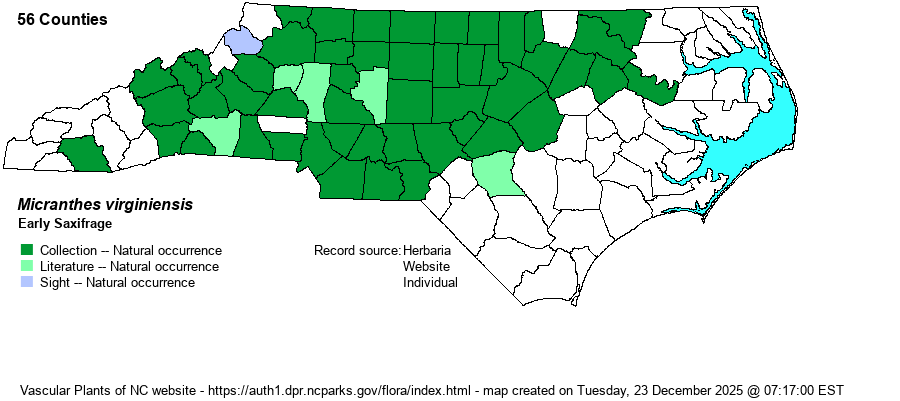| Author | (Michaux) Small | |
| Distribution | Throughout the Piedmont, and into the lower elevations of the Mountains; also ranges through the northwestern portion of the Coastal Plain. Ranges east to Northampton, Martin, Johnston, and Cumberland counties -- and thus mainly found in the Coastal Plain along brownwater rivers. It is absent from the Sandhills proper.
This is a widespread Eastern species, ranging from eastern Canada south to central GA and northern LA. It is scarce on the Coastal Plain. | |
| Abundance | Common across the Piedmont; fairly common along brownwater rivers in the upper Coastal Plain. In the Mountains, can be fairly common to locally common in the central counties, especially at lower elevations; scarce in the northern and southwestern counties. Its scarcity in the southwestern counties is puzzling, as few other Micranthes species occur in the area to compete with it, and many of these counties contain considerable elevations below 2,000 feet. | |
| Habitat | This species is found mostly in shaded rocky places, or at least over thin soil, favoring humid sites. It grows best along streambanks, along steep and rocky slopes, on shaded rocks in moist woods, and in various other sites. |
| Phenology | Blooms in early to mid-spring, from February into May. It fruits shortly after flowering. | |
| Identification | This is the Micrantes of the Piedmont, the only one in the genus found at elevations below 1,000 feet in elevation. It has a basal rosette of numerous ovate to almost triangular leaves, each only about 2 inches long and 1 inch wide, with a long tapering base. The margins are serrated to crenate, and the teeth are rounded. The flowering stem is very thick and hairy/sticky, growing only to about 1 foot tall, topped by a rather short and dense cluster of white flowers, each about 1/3-inch across. Though this species has many fewer flowers than others in the genus, the flowers are more easily visible owing to a tighter inflorescence and slightly larger petals. The rosettes of light green to glaucous green basal leaves are a common sight on creek banks, often on the steepest part of the bank, at times tantalizingly just of out reach for a close photo. In the mountains, you may need to be a bit more careful in the identification, as both M. careyana and M. caroliniana are locally present, as well as the much longer-leaved M. petiolaris and M. micranthidifolia. However, these first two have darker green leaves, often about as wide as long, and grow in deeper shade in moist rock crevices; their flower stalks are slender and not thick and hairy. | |
| Taxonomic Comments | This species and the other NC Micranthes were formerly in the genus Saxifraga.
| |
| Other Common Name(s) | Virginia Saxifrage | |
| State Rank | S5 | |
| Global Rank | G5 | |
| State Status | | |
| US Status | | |
| USACE-agcp | FAC link |
| USACE-emp | FAC link |

